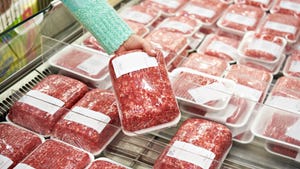Protecting against lice this winter
Lice infestations lead to lost performance and profitability. Be prepared to manage lice this winter.
November 16, 2016

The impact of lice on cattle
As we move into the cold winter months when lice populations increase, it’s critical to help your clients monitor cattle behavior to better control lice. Infestations cost the U.S. cattle industry more than $125 million annually.1,2 Moderate to heavy lice infestations can significantly reduce gain by as much as 9.2 percent, which is equivalent to 0.21 pounds per head per day in growing cattle.1,3,4
“When we see heavy lice populations in growing cattle, there is a larger impact than most producers realize,” said Doug Hufstedler, Ph.D., Elanco beef technical consultant. “Lice populations reduce average daily gain, decrease feed efficiency, increase susceptibility to other diseases, decrease body condition score and cause damage to fences, equipment and buildings. All of those things combined can significantly reduce performance, so it’s key to watch for lice in the winter.”
Monitoring lice
There are two types of lice that infest cattle — chewing and sucking. Sucking lice tend to cause the most severe infestations,5 which are the most obvious to spot.
“With more lice comes more irritation,” says Hufstedler. “That causes cattle to rub against available objects, which allows you to more quickly identify the issue. However, lighter infestations still lead to performance losses, so it’s important to teach your clients how to monitor cattle for lice.”
In the winter, as populations increase, lice tend to gravitate towards the dewlap, muzzle, back, sides, tailhead, neck, side of the face and around the eyes. The Kentucky Cooperative Extension Service recommends examining five one-inch areas on the face, dewlap, neck, back and base of the tail. 5 Look first for eggs, then carefully part the hair to look for lice.5 Treatment should begin when lice densities average more than three per square inch of surface area skin.1
Treating lice
“Good animal husbandry practices can help prevent lice, but the only way to get rid of lice is through an effective treatment program,” says Hufstedler. “Ensuring your clients have the right program in place can help them minimize the impact of lice on performance.”
StandGuard® Pour-on insecticide offers effective, powerful control against both chewing and sucking lice throughout the winter. Its quick-kill action is ready-to-use and designed to provide season-long protection in one application with the easy-to-use application gun. StandGuard Pour-on is available in both a 30 fl oz (900 mL) bottle with an easy squeeze-and-pour design and a 4.5 L size that is convenient for larger operations.
“StandGuard contains gamma-cyhalothrin, the latest technology for beef cattle in the pyrethroid class, helping producers get ahead of the infestation before it escalates,” says Hufstedler.
For more information on implementing StandGuard Pour-on with your clients, reach out to your Elanco technical consultant or visit Elanco.us.
The label contains complete use information, including cautions and warnings. Always read, understand and follow the label and use directions.
1Campbell, J. B. 1992, Revised 2006. Lice control on cattle. NebGuide G1112.
2Kunz, S. E., K. D. Murrell, G. Lambert, L. F. James and C. E. Terrill. 1991. Estimated losses of livestock to pests. CRC handbook of pest management in agriculture. 1:69- 98.
3Byford, R. L., M. E. Craig & B. L. Crosby. 1992. A review of ectoparasites and their effect on cattle production. J. Ani. Sci. 70:597-602.
4Gibney, V. J., J. B. Campbell, D. J. Boxler, D. C. Clanton & G. H. Deutscher. 1985. Effects of various infestation levels of cattle lice on feed efficiency and weight gains of beef heifers. J. Econ. Entomol. 78:1304.\
5Townsend, L. 2000. “Lice on beef and dairy cattle.” Kentucky Cooperative Extension Service.
Elanco®, StandGuard® and the diagonal bar are trademarks owned or licensed by Eli Lilly and Company, its subsidiaries or affiliates.
© 2016 Eli Lilly and Company, its subsidiaries or affiliates.
fvbeef 2713-8 |USBBUSGP00019
You might also like:
A ranchers time warp: The insanity can't continue, right?
Head fake: September fed market fooled just about everybody
9 new pickups for the ranch in 2016
Is snow an adequate winter water source?
Young ranchers, listen up: 8 tips from an old-timer on how to succeed in ranching
You May Also Like



